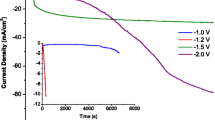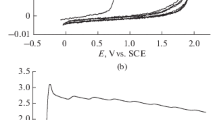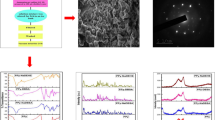Summary
A new method for the synthesis of conducting polypyrroles (PPy), based on chemical and combined electrochemical-chemical oxidation of pyrrole monomers in the presence of nitroxyl radical (TEMPOL-2,2,6,6-tetramethyl-4-hydroxy-1-oxy-piperidyl) as oxidation agent (in its oxidation state) and redox mediator respectively is described. The PPy films obtained are extremely porous and the electrical conductivity (σ) of the resulting PPy samples ranges from 1 to 100 S cm−1. PPy prepared in aqueous solutions has a lower conductivity σ∽1 S cm−1 as compared to the PPy prepared in acetonitrile solutions with conductivity of about 100 S cm−1. The PPy films are quite compact and thick films (1 mm) can be pealed off from the electrode surface and pressed as a disc for further studies. Only after partial reduction of polypyrrole film the spin-probed PPy was obtained. The concentration of nitroxyl radicals incorporated in the polymer matrix can be changed using various degrees of polymer reduction. The anisotropic broadening of the observed ESR lines indicates a low mobility of incorporated nitroxyl radicals in the PPy matrix. The electronic interaction between the nitroxyl groups and the paramagnetic centers of the polymer chains, polarons, causes an ESR line broadening of polaron signal both on air (1.1 mT) and in vacuum (0.7 mT) as compared to unmodified PPy (0.2 mT on air, 0.05 mT in vacuum).
Similar content being viewed by others
References
Skotheim TA (1986) Handbook of Conducting Polymers. Vol. 1, Marcel Dekker, New York, p. 81
Salaneck WR, Lundström I and Ranby B Eds (1993) Conjugated Polymers and Related Materials. Oxford University Press, Oxford, New York, Tokyo, p. 149
Omastová M, Lazár M and Košina S (1993) J. Electroanal. Chem. 361: 169
Košina S, Balúch S, Annus S, Omastová M and Krištín J (1994) J. Mat. Sci. 29: 3403
Beck F and Oberst M (1989) Synth. Met. 28: C43
Zinger B (1989) Synth. Met. 28: C37
Rozancev EG and Zdanov RI (1987) The Nitroxyl Radicals, Nauka, Moscow
Wassermann AM and Kovarski AL (1986) Spin Probes and Labels in Physics and Chemistry of Polymers, Nauka, Moscow
Pelekh AE, Goldenberg LM and Krinichnyi VI (1991) Synth. Met. 44: 205
Winter H, Gotschy B, Dormann E and Naarmann H (1990) Synth. Met. 38: 341
Audebert P, Bidan G, Lapkowski M and Limosin D, in: Kuzmany H, Mehring M and Roth S (eds.) (1987) Electronic Properties of Conjugated Polymers, Springer, Berlin p. 366
Paasch G, Schmeißer D, Bartl A, Naarmann H, Dunsch L and Göpel W (1994) Synth. Met. 66: 135
Thomas G and Mohanty JG (1982) Indian J. Chem. 21A: 451.
Sümmermann W and Deffner U (1975) Tetrahedron 31: 593
Skothheim TA (1986) Handbook of Conducting Polymers Vol. 1, Marcel Dekker, New York, p. 265.
Kowalik J, Nguyen HT and Tolbert LM (1991) Synthetic Met. 41: 435
Naarmann H and Koehler G, Ger. Pat. (1984) No. 3,246,319
Author information
Authors and Affiliations
Rights and permissions
About this article
Cite this article
Rapta, P., Bartl, A. & Dunsch, L. Preparation of highly conducting and spin-probed polypyrroles using coupled electrochemical-chemical synthesis in the presence of nitroxyl radicals. Polymer Bulletin 37, 751–757 (1996). https://doi.org/10.1007/BF00295773
Received:
Revised:
Accepted:
Issue Date:
DOI: https://doi.org/10.1007/BF00295773




